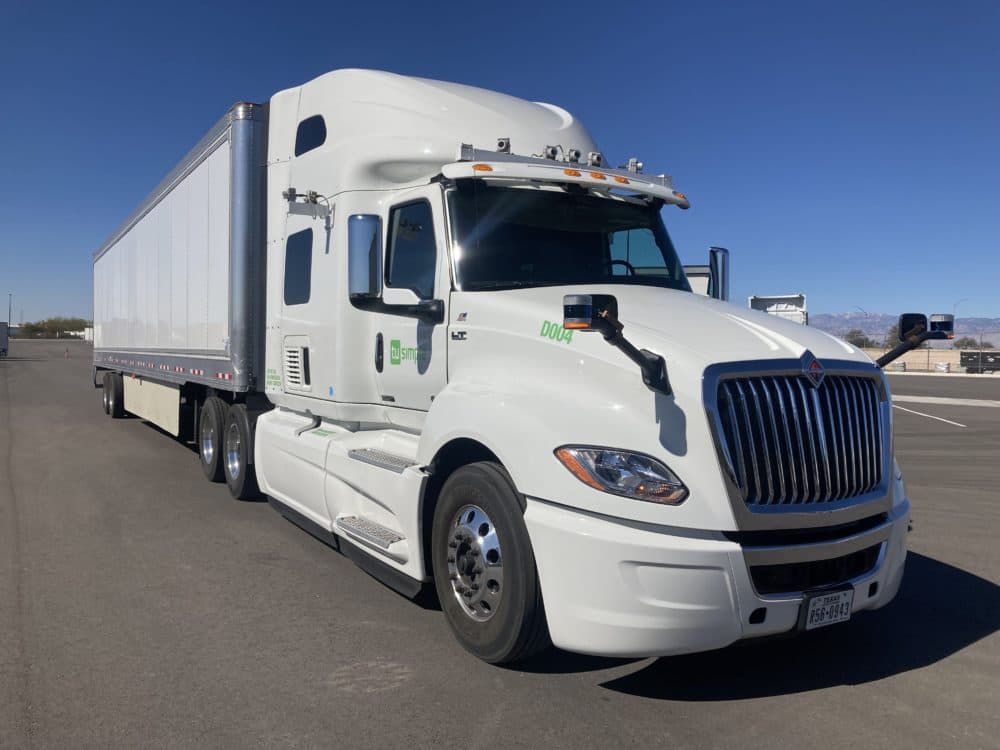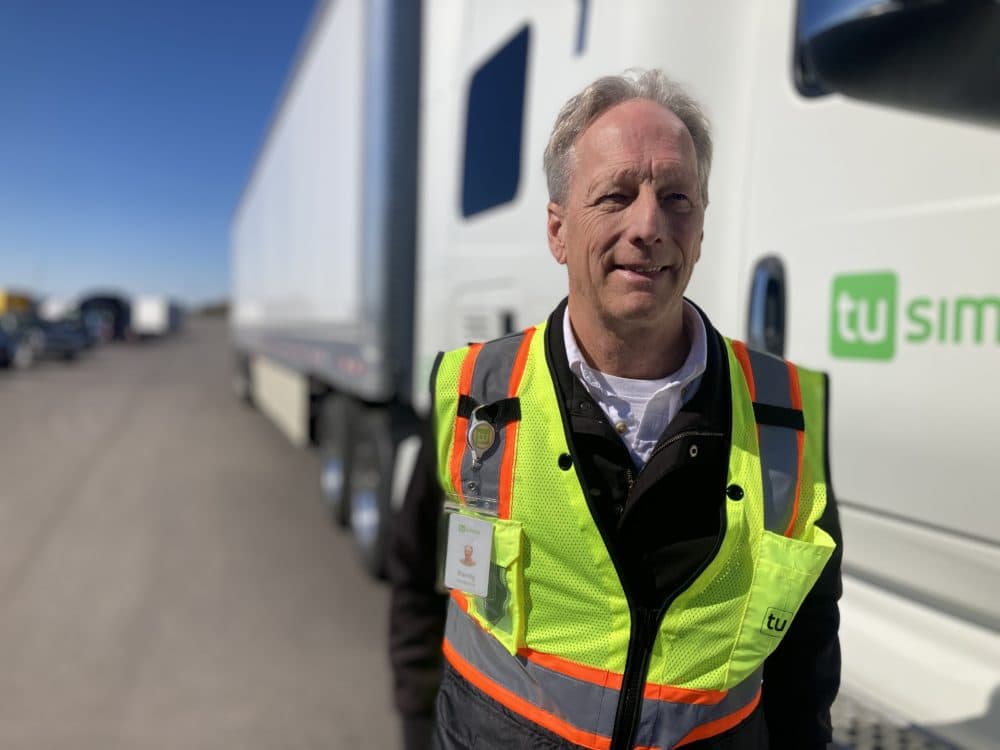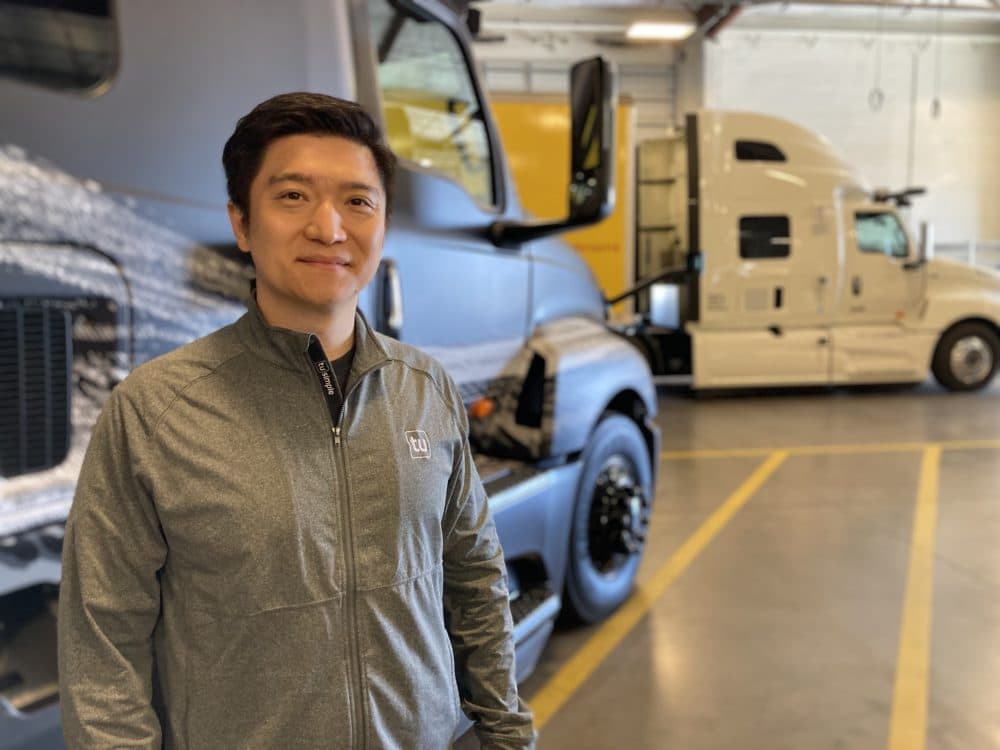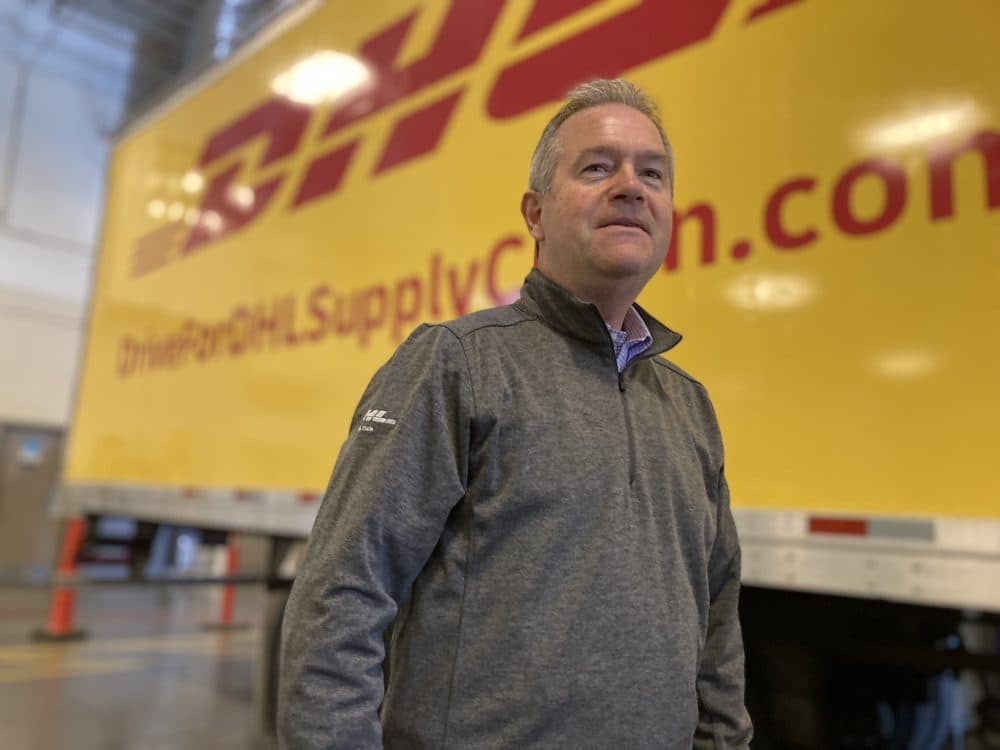Advertisement
Take a ride in a robot semi-truck, a potential solution to snags in U.S. supply chain
Resume
Last year, I jumped behind the wheel of a semi-truck to learn what it takes to get a commercial driver's license.
The country is short about 80,000 truck drivers, according to the American Trucking Association. And schools like the one I went to in Phoenix are busy trying to keep up.
At the time, instructor Tim Kerstein told me about a company down the road in Tucson called TuSimple, which is making deliveries in semi-trucks without drivers.
“It is an automated truck driving company. It's here. It's not going to stop. It's going to only get better,” Kerstein said. “But trucks are not going to fill themselves. They're not going to unload themselves. There's going to be a demand for drivers for decades to come.”
That was enough to get me down to Tucson, where TuSimple is making deliveries in decked-out rigs. Koabi Brooks, TuSimple’s director of technical operations, says the company’s trucks have cameras all around the outside.
As we walk around the truck I can see that it's loaded up with technology, though most of the antennas, cameras and sensors that allow this truck to drive on its own are easy to miss. LiDAR sensors help with field detection and GPS tells the truck where to go.
“I think the average passenger car passes this truck on the highway without two thoughts,” Brooks says.
Brooks is my guide on a test ride up Interstate 10, right through the heart of Tucson. If all goes well the computer will navigate on ramps, avoid motorcycles and landscaping trucks changing lanes at 75-miles per hour, and slow down for emergency vehicles on the shoulder.
We climb into the back of the cab, strap in and then meet two other people up front. One is an engineer in the passenger seat there to read the data streaming in from the computer. And Randy Redwine is in the driver's seat ready to take over in case something goes wrong.
Redwine says he’s made two trips in the truck this morning without intervention. He enjoys watching the trucks improve— but it’s something he didn’t see coming when he started driving 40 years ago.
“I couldn't even imagine it, no, that a truck could drive itself,” Redwine says. “But here we are."
To start the 60-mile trip, Redwine pushes a button and his hands come off the wheel.

Before we share in the experience of riding in a robot truck, let's understand why it's on the road in the first place.
TuSimple's Cheng Lu says the company wants to reshape the $4 trillion global freight industry by solving the mismatch between supply and demand for drivers and trucks
Lu says his colleagues joke about how the company is automating “the most boring truck routes,” long-haul routes that require drivers to be away from home for two to three weeks. These routes have the most turnover and are most impacted by the driver shortage, he says.
“If we can make those routes autonomous, then that frees up our human drivers to do the first mile, last mile, to do the e-commerce deliveries,” he says, “and that allows everyone to be more efficient.”
Last-mile jobs aren’t nearly as lucrative as long-haul trucking jobs, which pay well. Lu says that despite this, the difficulty of driving long routes makes it hard to recruit and retain workers. He thinks TuSimple’s technology is the solution to the shortage.

When I met Lu in February inside the company's sprawling Tucson warehouse, he was TuSimple's CEO. He has since stepped into an advisory role, which caught investors off guard. The company is also yet to turn a profit and its stock has fallen about 70% since going public a year ago.
But last December, the start-up reached a key milestone: One of its trucks made a delivery from Tucson to Phoenix without a backup driver behind the wheel. In fact, there was no one in the truck at all. It's called a driver-out run — and this was an industry first.
For Lu, attempting the 80-mile run required a great deal of confidence on the company’s part. Over six years, the company’s 100 trucks drove 6 million miles to prepare, he says.
“It's very significant because it demonstrates that we're safe,” he says. “You can't do driver-out run if there's something you haven't figured out.”
TuSumple has more work ahead to scale up, Lu says, but he’s confident that the trucks can cover that 80-mile route without a human driver.
Or a lot more work, according to Phil Koopman. It doesn’t make sense to remove the backup driver for safety testing, says the self-driving safety expert for 25 years and Carnegie Mellon professor.
TuSimple's 6 million miles on the road is sort of irrelevant: In this country, a fatal crash happens every 100 million miles. And there isn’t any data to suggest that computers are safer drivers than humans, Koopman says.
To its credit, he says TuSimple is following safety standards that other companies don't and is among the most transparent in the industry.
“The risk is that you have these companies that are chasing valuation, that are chasing being first to market, and there's tremendous incentive — billions of dollars — to just get out on the road,” Koopman says. “And given that there's no regulations dealing with software safety, the companies are deciding when they're ready.”
When it comes to the driver shortage, Koopman says companies are using it as an excuse to get on the road even faster.
“There are other ways to solve the driver shortage than by inventing self-driving trucks,” he says. “You could pay the drivers more and treat them better.”

Back in the Tucson warehouse, there’s no question that companies are clamoring to be first.
Jim Monkmeyer is the president of transportation for DHL Supply Chain, one of the largest shipping companies in the world. The company is seeing costs and wages increase by double digits, he says, which is raising prices for consumers. But he says autonomous driving could help.
DHL plans to buy 100 TuSimple trucks and recently hired the company to ship air conditioning equipment from San Antonio to Dallas. Monkmeyer says autonomous trucks run this route every week.
“Without the need for stopping for driver breaks, those trucks can move across the country in fewer days. What might be a three-day transit could be done by autonomous trucking in one to two days,” he says. “And that's really game-changing for us in terms of getting product faster and faster to the end customer.”
Quicker routes save the company and consumers money, he says. And getting these trucks first could give the company a competitive advantage.
In the meantime, as TuSimple continues to test new routes, you might see a robot truck like the one I rode in sometime soon.
It’s exciting and scary all at the same time, much like the moment when the 72-foot truck Brooks and I were riding in slowly turned left at a green light. The truck abruptly stopped while the computer decided what to do. It safely moved forward once the oncoming vehicle passed.
Ready or not, here they come.
Peter O'Dowd produced and edited this interview for broadcast with Todd Mundt. Allison Hagan adapted it for the web.
This segment aired on April 1, 2022.
